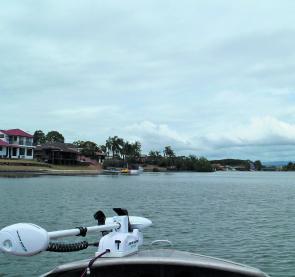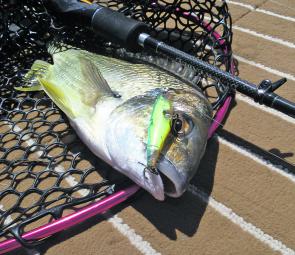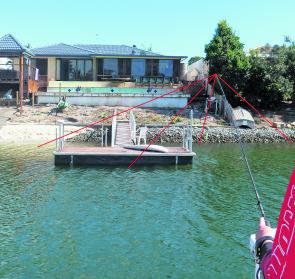As we come out of the cooler months and the water starts to heat up once again, bream become more active and tend to sit higher in the water column searching for food. It’s not uncommon to see bream rounding up schools of shrimp and attacking them off the surface. Once I see this, one particular technique comes to mind – surface lures.
Whether it’s on top of sand flats or right up against a bank in the canals, bream find it very hard to resist a surface lure walking across the top. Finesse surface fishing is one of my favourite techniques to target good numbers of bream in the canals and rivers.
What separates surface lures from all the rest is the fact that you get to watch the fish follow your lure out from its home and hopefully slurp it in. The intense moments when there are 5 or more bream circling under the lure always excites me the most and makes fishing with surface lures an incredibly fun pastime.
In the warmer months bream will be sitting up in relatively shallow water and that’s why surface lures are a must-have. There is no point casting in the middle of a canal and hoping a bream will come up from 15ft down to eat your lure.
When fishing canals I cast either at the bank where it’s shallow then work the lure into the deeper water or cast right along the whole bank to cover a lot of ground. Structure worth casting at includes rock bars, overhanging trees, boat ramps, moored boats, jetties and any other form of structure available in canals and rivers.
Casting at pontoons is also a great way to use a surface lure. Often bream will come out from under a pontoon and smash a surface lure without any hesitation. When fishing other shallow areas such as sand flats, bream tend to sit on the edges of drop-offs and weed beds. Knowing this makes it easier to cast accurately at spots where fish are lying. This way you’re not wasting time casting at fishless areas.
When finesse surface fishing it is vital to have the correct gear. Having the right lure is often not enough to trick a bream into eating your surface offering. When a fish comes up to the surface they become wary of what’s around them. A lot of the time if you’re using heavy leader or sitting too close to the fish they won’t bother having a go. That’s why you must use a long light leader and big casts.
Each day a bream’s mood will change. Some days they smash anything you cast at them, then other days they will sit under your lure and just watch it. How they react to your lures on the day will determine how heavy your leader will be. As a starting point 4lb Toray Upgrade is perfect – it’s super tough and can withstand bream without any difficulty; 6lb leader and upwards is fine when the water is murky and the fish aren’t too disturbed by heavier leaders or when fishing around sharp structure such as rocks and oysters. If you find that fish are following the lure but not tempted to strike then try to downsize your leader. A rod length of light leader under 4lb may become necessary on these days.
There are two main types of leaders available: monofilament fishing line and fluorocarbon.
Monofilament floats on water so it can be useful when using small surface lures so that the line won’t drag the lure underwater while in the middle of a retrieve. However, in most cases it’s more visible underwater than fluorocarbon, which means fish may spot the leader.
Alternatively, fluorocarbon fishing line sinks, this is great for other kinds of lures such as soft plastics and hardbodies. Fluorocarbon can still be used for surface lures but it has potential to become a problem when using leaders over 6lb. I find that after a long pause, the fluorocarbon leader has sunk and tends to drag the lure under for a short period of time once the retrieval begins. Thankfully, fluorocarbon leaders with a rating of 4lb or less don’t have much effect on the action of small surface lures. It is also very abrasive resistant and is almost impossible to see underwater. For these reasons I usually tie on fluorocarbon over mono in most light line situations.
For mainline, any good quality braid will do. Something like Toray Radius Super Pe is great and well worth spending that little bit extra money. If you want something more cost effective then green Sunline Super Pe is a popular choice. It comes in 150m or 300m spools so you can easily get two uses out of the one packet.
When it comes to choosing an outfit for surface fishing you need a rod with a suitable action. A quick and responsive rod tip is required to get the best action out of your lures. I also prefer a slightly longer rod around the 7ft mark as it makes casting further a lot easier. At the moment I use a Daiwa Black Label MLFS matched with a Daiwa Sol. This rod is rated at 2-3kg and combined with a fast taper means that it’s capable of throwing ultra light surface lures a mile.
Lure choice is just as important when it comes to surface fishing. There are many kinds of surface lures available, such as poppers and walkers that sometimes have the advantage of doubling as a sub surface lure. I find that walkers or (walk-the-dog lures) are the most productive in canals because of their natural appearance and action. Poppers are also effective especially when trying to attract fish from further away. Popular brands that produce these lures include O.S.P, Imakatsu, DUO, Atomic, Lucky Craft, Ecogear and Berkley.
By far my favourite two surface lures would be the O.S.P Bent Minnow 76 and Imakatsu Dilemma Popper. The O.S.P Bent Minnow can be walked across the surface plus it has the option of being drawn under for when the fish are a little hesitant. The Dilemma Popper is purely a walk-the-dog lure but has a small-cupped face that creates more disturbances in the water than any regular walker. Other lures that have produced in the past include Berkley Scum Dog, Lucky Craft NW Pencil and Ecogear PX45. It’s best to have a collection of surface lures and trial each one to decide what you like most.
Each type of lure has a different action and works best using unique shakes of the rod.
For poppers it can be as simple as casting to the lure at a bank, and giving the rod a couple quick flicks then pausing the lure. Poppers have a large cupped face and once you give the rod a sharp flick downwards it pulls the lure forward, which creates a small splash around the lure. This can alert fish from close by to come in and investigate.
Walk-the-dog lures when worked correctly zigzag from side to side imitating a baitfish or shrimp. To get the lure walking you have to continuously shake the rod tip and combine it with a slow roll. Once you get the shakes in time with the zigzag action the lure will dart from side to side and look perfectly natural to nearby fish. Walk-the-dog lures are one of my favourites purely because of their versatility. They can be worked extremely slow or very erratic across the surface to intrigue fish.
As stated earlier, some lures, such as the Bent Minnow, can be worked under the surface by slowly drawing the rod tip downwards. Once the lure is under the water, start a slow retrieve with plenty of smaller downward shakes of the rod so the lure doesn’t rise back up to the top.
Once you have a bream’s attention let the lure pause and most of the time they will take this as an opportunity to strike. Wait for any movements in your line or for the lure to go under the surface before you strike back. A lot of the time a bream will hit and miss the lure so it’s imperative not to pull it away because the lure will no longer be in the strike zone and this can frighten the fish. In recent sessions when a fish has hit and missed, I have given the lure one or two more twitches directly after the hit. This makes the fish super agitated because their meal seems to be escaping and often the next hit will be super aggressive.
Reads: 10126
Overcast conditions are perfect for surface fishing because the cloud cover gives fish more confidence to come up to the surface.

O.S.P Bent Minnow worked slightly under the surface was enough to convince some finicky land-locked bream.

Imakatsu Dilemma Popper producing some good quality bream from the canals.

Always make multiple casts at pontoons and the areas beside them while fishing in canals.




